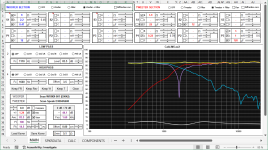Hmm, hard to put into words... Take a sheet of paper and flick the edge with your finger... Not too dissimilar in quality to the sound of a woofer with a deformed voice coil rubbing against the gap. I guess technically it must be distortion around the ~500Hz frequency where the rather large resonance peak is. And all the usual disclaimers apply: this is my personal and subjective perception, and it's based on three different attempts at implementing a crossover with the D6600 (with a SS 18/W8545, Seas W18NX and Volt BM228.8) and seeing if I could get away without the RLC trap. In the first case I ended up using a different tweeter after trying a few, the other two are up and running with the trap in place.
That nasal sound is easy to hear during sine sweep measurement, one can train the ear on that. RLC can compensate Fs peak entirely, or parallel resistor to the tweeter, which dampens the peak partially + lowers the treble level.
I did try the parallel resistor of course, that has worked fine for me with many other tweeters, but in this case, although it did reduce the annoying sound, it didn't get rid of it completely, at least not to my satisfaction. Again this is IME, YMMV, etc., though apparently I'm not the only one, this is from Zaph's write-up of his ZRT project: "The tweeter [...] also requires a conjugate impedance flattening notch across the terminals. A traditional L-pad would not have been enough to damp the tweeter's impedance peak and a LCR circuit will be needed with almost all 6600 applications to avoid ringing."
Hi,
thank you for your ansewer.
Now i have some questions:
1) for SB I noticed that the finish of the faceplace is very delicate, that is, as soon as you touch it even with a non-hard object or touch it with your hands it marks and seems as if it were dirty, has this happened to you?, how do you clean it?, really frustrating.
For example i only touched it with clean hands to mount it and it already seems dirty
2) regarding the running-in, can anyone tell me how Scan-speak and SB change tonality, i.e. for example SB becomes more detailed with a deeper scene and scan-speak darker with a less deep scene... (it's just an example ), how many hours are needed for both?
3) for the D6600 in a 4-way a 12db made up of a 6.8uF capacitor in series and a 0.27mH inductor in parallel without attenuation, it could be a good filter (I have already tested it by listening) as regards the power handling?
thank you for your ansewer.
Now i have some questions:
1) for SB I noticed that the finish of the faceplace is very delicate, that is, as soon as you touch it even with a non-hard object or touch it with your hands it marks and seems as if it were dirty, has this happened to you?, how do you clean it?, really frustrating.
For example i only touched it with clean hands to mount it and it already seems dirty
2) regarding the running-in, can anyone tell me how Scan-speak and SB change tonality, i.e. for example SB becomes more detailed with a deeper scene and scan-speak darker with a less deep scene... (it's just an example ), how many hours are needed for both?
3) for the D6600 in a 4-way a 12db made up of a 6.8uF capacitor in series and a 0.27mH inductor in parallel without attenuation, it could be a good filter (I have already tested it by listening) as regards the power handling?
3) It all depends of course on the other drivers and rest of the crossover, but, on paper, it doesn't look like the kind of thing I'd use in a 4-way, see attached the response I get with your proposed filter (in red) vs. the response with the crossover I designed for my 2-way with the Seas W18NX midwoofer (in green), which is roughly a 4th-order Linkwitz-Riley @ 1.6 kHz, just as an example of an actual crossover designed specifically for the measured response of the drivers. The problem I see isn't power handling (whether that's ok or not depends, among other things, on how much power you need to handle), it's the very gentle and shallow slope you get. Good luck integrating that with three other drivers in a 4-way.
I think it goes without saying, but you can't expect to be able to design a crossover properly by throwing some random components at one of the drivers and deciding that you like what you hear...
I think it goes without saying, but you can't expect to be able to design a crossover properly by throwing some random components at one of the drivers and deciding that you like what you hear...
Attachments
I'm sorry that you think there isn't a project behind it, you're wrong, I've been working on it for a long time and that transfer function is strongly desired.3) It all depends of course on the other drivers and rest of the crossover, but, on paper, it doesn't look like the kind of thing I'd use in a 4-way, see attached the response I get with your proposed filter (in red) vs. the response with the crossover I designed for my 2-way with the Seas W18NX midwoofer (in green), which is roughly a 4th-order Linkwitz-Riley @ 1.6 kHz, just as an example of an actual crossover designed specifically for the measured response of the drivers. The problem I see isn't power handling (whether that's ok or not depends, among other things, on how much power you need to handle), it's the very gentle and shallow slope you get. Good luck integrating that with three other drivers in a 4-way.
I think it goes without saying, but you can't expect to be able to design a crossover properly by throwing some random components at one of the drivers and deciding that you like what you hear...
I don't understand what the problem is, sorry.
What software did you use for the simulation? (very intresting interface)
Apologies diypass, I misinterpreted what you said. I'd be curious to know more about the rest of your project!
I use an Excel spreadsheet that I created myself, attached is a screenshot. I've used it for years and, although I've checked it against Xsim and others (and of course against real measurements) and it works just fine, I've never shared it because it's quite complicated and I'm not prepared to guarantee that it's completely bug free...
I use an Excel spreadsheet that I created myself, attached is a screenshot. I've used it for years and, although I've checked it against Xsim and others (and of course against real measurements) and it works just fine, I've never shared it because it's quite complicated and I'm not prepared to guarantee that it's completely bug free...
Attachments
Besides the crossover, do not forget the big effect of cabinet diffraction on tweeter response. Same tweeter, but with a bit of an edge at the cutout or on the cabinet edge can be very different sounding, despite similar on-axis response.
yes, right, i knowBesides the crossover, do not forget the big effect of cabinet diffraction on tweeter response. Same tweeter, but with a bit of an edge at the cutout or on the cabinet edge can be very different sounding, despite similar on-axis response.
very important edge diffraction
- Home
- Loudspeakers
- Multi-Way
- Scanspeak D6600

